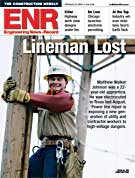 James Tomaseski of the International Brotherhood of Electrical Workers says the task force has applied to the Dept. of Labor for an $800,000 grant to hire a company to meet with linemen and survey them about their training.
James Tomaseski of the International Brotherhood of Electrical Workers says the task force has applied to the Dept. of Labor for an $800,000 grant to hire a company to meet with linemen and survey them about their training.
We cant do anything until we know that we can fund the project, Tomaseski says. Without OSHA and Labors budget, we dont know where the dollars will be.
The Labor Dept.s Occupational Safety & Health Administration is leading the task force that was formed last August in response to a spike in accidents during power line construction and repair in recent years. Both OSHA and other members of the task force say that the Labor Dept. funding is not vital and that much important work is being done.
But Tomaseski insists the funding is a key to one of the task forces original goals of meeting and talking to lineman around the country.
Since 2000, informal counts suggest that yearly fatalities during powerline work have jumped to 20 from what had been an average of 12. In recent years there has been more work and care devoted to the nations transmission and distribution grid, with many young, less-experienced linemen serving on smaller crews. The problem was first disclosed by ENR in a feature story that appeared Feb. 23, 2004. The cover photo showed a 22-year-old apprentice named Mathew Walker Johnson, who died in an accident in Texas in August, 2003. His death symbolized the dangers experienced by a new generation of lineman.
Not everyone believes the funding and survey is vitally important to the effort.
Some of the information to be gathered with Labor Dept. funding isnt vital, says Gregory Baxter, a regional administrator of OSHA in Denver. He is on the steering committee of the task force, which is called the Strategic Safety Partnership. My personal view is that [the grant] is not critical. Enough information is available, he says, for the task forces best practices team to do its job.
The task force includes a voluntary coalition of power transmission and distribution contractors and industry related organizations. Members include MYR Group Inc., Henkels & McCoy Inc., Pike Electric, Inc., Quanta Services Inc., Utility Services Inc., the National Electrical Contractors Association, the Edison Electric Institute and the IBEW.
The task force has conducted an analysis of the causes of fatalities and injuries but has not yet made its findings public.
A key goal of the task force is to change the culture of line construction, says H. Brooke Staufer, NECAs executive director for standards and safety. Linemen have traditionally been macho cowboys but that same quality of initiative makes them hard to supervise, he says.
At the same time, safety improves productivity and we need to get that message across to foremen and supervisors.
s a task force on power line accidents presses ahead with its work, the safety director of the electrical workers union complains that the effort is being hampered by a lack of financial support from the Labor Dept.
Post a comment to this article
Report Abusive Comment